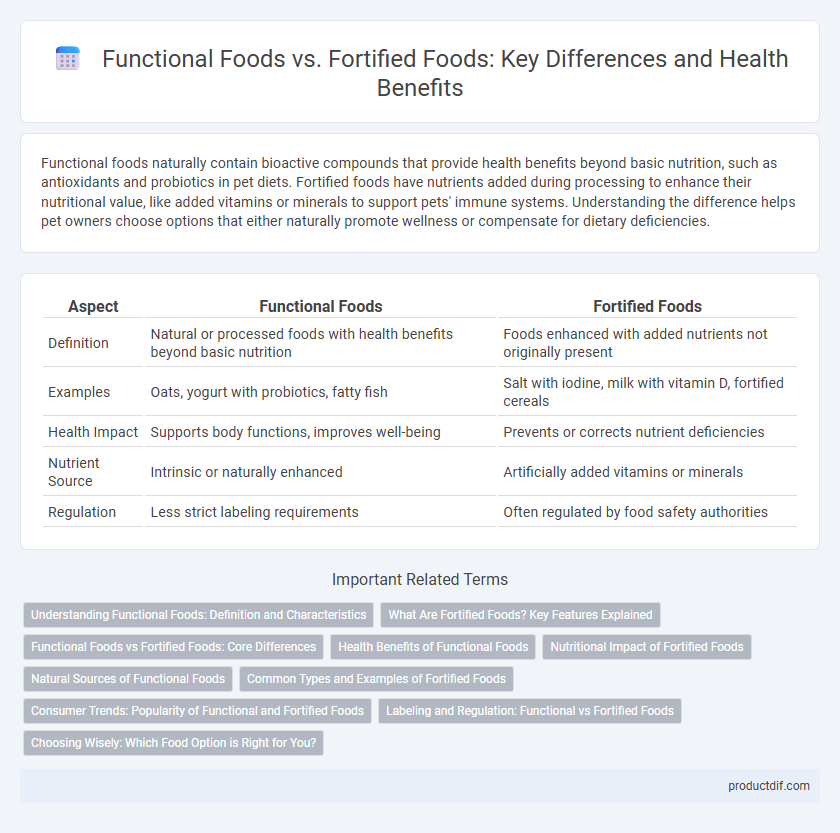Functional foods naturally contain bioactive compounds that provide health benefits beyond basic nutrition, such as antioxidants and probiotics in pet diets. Fortified foods have nutrients added during processing to enhance their nutritional value, like added vitamins or minerals to support pets' immune systems. Understanding the difference helps pet owners choose options that either naturally promote wellness or compensate for dietary deficiencies.
Table of Comparison
| Aspect | Functional Foods | Fortified Foods |
|---|---|---|
| Definition | Natural or processed foods with health benefits beyond basic nutrition | Foods enhanced with added nutrients not originally present |
| Examples | Oats, yogurt with probiotics, fatty fish | Salt with iodine, milk with vitamin D, fortified cereals |
| Health Impact | Supports body functions, improves well-being | Prevents or corrects nutrient deficiencies |
| Nutrient Source | Intrinsic or naturally enhanced | Artificially added vitamins or minerals |
| Regulation | Less strict labeling requirements | Often regulated by food safety authorities |
Understanding Functional Foods: Definition and Characteristics
Functional foods are naturally rich in bioactive compounds that provide health benefits beyond basic nutrition, such as antioxidants, probiotics, and omega-3 fatty acids. These foods contribute to disease prevention and improved physiological functions by enhancing immune response, reducing inflammation, and supporting gut health. Unlike fortified foods, functional foods derive their health-promoting properties from their inherent components rather than added nutrients.
What Are Fortified Foods? Key Features Explained
Fortified foods are products enhanced with additional nutrients that are not naturally present or are present in insignificant amounts, such as vitamins, minerals, or fiber, to improve their nutritional value. Common examples include milk fortified with vitamin D, orange juice with added calcium, and cereals enriched with iron and B vitamins. These foods play a crucial role in addressing nutrient deficiencies in populations and promoting overall health by providing targeted nutritional benefits beyond their original composition.
Functional Foods vs Fortified Foods: Core Differences
Functional foods naturally contain bioactive compounds that promote health benefits beyond basic nutrition, such as probiotics in yogurt or antioxidants in berries. Fortified foods have nutrients added to enhance their nutritional value, like vitamin D added to milk or iodine added to salt. The core difference lies in functional foods offering inherent health advantages, while fortified foods provide targeted nutrient supplementation.
Health Benefits of Functional Foods
Functional foods contain naturally occurring bioactive compounds that promote optimal health, such as antioxidants, probiotics, and omega-3 fatty acids, which support immune function and reduce chronic disease risk. These foods improve physiological functions beyond basic nutrition, enhancing cardiovascular health, digestion, and cognitive performance. Fortified foods, by contrast, have nutrients added artificially, but functional foods offer intrinsic health benefits due to their naturally enriched composition.
Nutritional Impact of Fortified Foods
Fortified foods are enhanced with added nutrients such as vitamins and minerals that are not naturally present or are in insufficient amounts, improving overall nutritional intake and addressing specific deficiencies in populations. Common examples include iodized salt, fortified milk with vitamin D, and cereals enriched with iron and folic acid, which help reduce risks of diseases related to nutrient deficiencies like goiter, rickets, and anemia. This targeted nutrient enhancement in fortified foods plays a crucial role in public health strategies to combat malnutrition and improve dietary quality on a large scale.
Natural Sources of Functional Foods
Functional foods naturally contain bioactive compounds such as antioxidants, probiotics, and polyphenols that promote health and reduce disease risk. Common natural sources include berries, leafy greens, yogurt, and nuts, which provide essential nutrients and enhance physiological functions. Unlike fortified foods, which have added vitamins or minerals, functional foods derive their benefits directly from their inherent nutritional properties.
Common Types and Examples of Fortified Foods
Fortified foods commonly include products like iodized salt, vitamin D-enriched milk, and iron-fortified cereals, all designed to address specific nutrient deficiencies in populations. These foods undergo the intentional addition of essential vitamins or minerals during processing to enhance their nutritional profile. Unlike functional foods that naturally contain bioactive compounds promoting health benefits, fortified foods specifically target improved nutrient intake through supplementation.
Consumer Trends: Popularity of Functional and Fortified Foods
Functional foods, enriched with natural bioactive compounds like probiotics and antioxidants, increasingly attract health-conscious consumers seeking disease prevention and improved well-being. Fortified foods, enhanced with essential vitamins and minerals such as vitamin D and iron, remain popular for addressing specific nutrient deficiencies in diverse populations. Rising demand for clean-label, nutrient-dense options drives innovation and market growth in both functional and fortified food sectors.
Labeling and Regulation: Functional vs Fortified Foods
Labeling and regulation of functional foods focus on health claims supported by scientific evidence, ensuring consumers are informed about specific benefits related to bodily functions or disease risk reduction. Fortified foods require mandatory disclosure of added nutrients on labels according to regulatory standards, emphasizing nutrient enhancement rather than health claims. Regulatory agencies like the FDA and EFSA enforce distinct guidelines for each category to guarantee accurate information and consumer safety.
Choosing Wisely: Which Food Option is Right for You?
Functional foods naturally contain bioactive compounds that provide health benefits beyond basic nutrition, such as probiotics in yogurt or omega-3 fatty acids in salmon. Fortified foods have specific nutrients added during processing to address dietary deficiencies, like vitamin D in milk or iodine in salt. Choosing wisely involves evaluating personal nutritional needs, health goals, and any nutrient gaps to determine whether naturally occurring functional foods or nutrient-enhanced fortified options better support your overall wellness.
Functional foods vs Fortified foods Infographic

 productdif.com
productdif.com